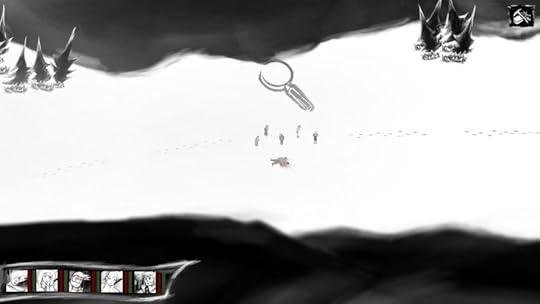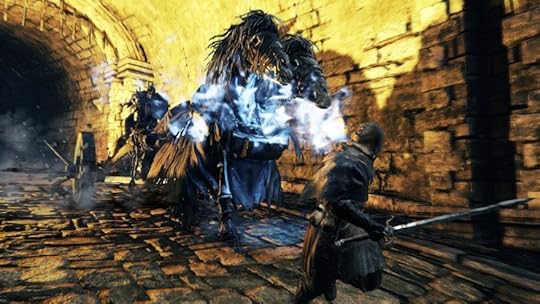Kill Screen Magazine's Blog, page 87
July 21, 2016
A new game pays tribute to the many unfortunate deaths of Oregon Trail
Juegos Rancheros’s Mystic Western game jam, held between June 16th and June 30th, was a beautifully prolific two-week international event that gave birth to 50 games about the West and the weird things that happen within it. Alongside projects like Black Gold and To West was Independence, Missouri, an off-kilter prototype from Pippin Barr, previously known for experiments like Game Studies and Sisyphus: The Game. A retelling of an unsuccessful session of the classic educational game Oregon Trail (1971), it’s appropriately mystic, and definitely Western. Now Barr’s releasing it proper.
Independence, Missouri, for the purposes of the game, is a tiny frontier town whose only depiction is half-hidden in the dirt. Its historical relevance, of such importance to the fifth grade teachers who just want to make class fun again, is barely mentioned. Instead it’s a jumping-off point for the doomed caravan that the player follows into the plains, inspecting their broken wagon wheels and firearms as yet another character dies of dysentery. If not for Barr’s stark dioramas and deep sky above the abandoned text boxes, it’d be a typical session of Oregon Trail.
The real Independence, Missouri is the fourth largest city in the state, a municipality right outside of Kansas City whose primary claim to fame is the birthplace of Harry S. Truman. To the north you find Liberty; to the south, Unity. Like the rest of Missouri, it’s best known as a place that people left. The California and Santa Fe trails began there, kickstarting the mass exodus westward that inspired so much of the Mystic Western game jam. While the real place approached what was left of its past by building up and around, expanding in that Midwestern way of cul-de-sacs curving around creeks, bracketed by houses so identical that they look unreal, Barr’s Independence has left the past to sink in the dust.
This is because Barr’s other main inspiration, besides Oregon Trail, is Percy Bysshe Shelley’s legendary poem Ozymandias. Yes, that one: “look on my works, ye mighty, and despair,” etc, etc. A poem that, despite its current oversaturation in pop culture, remains a powerful condemnation of permanence, illustrating that even the greatest of empires will eventually succumb to time. In a blog post detailing the process he went through to arrive at this concept, Barr says that the age and cult status of Oregon Trail worked well as an emblem of an “ancient” history to be represented in his dioramas.
As such, Barr quotes Shelley on Independence, Missouri’s itch.io page—with a little twist:
Everyone in the party has died! Nothing beside remains! Round the decay of that colossal wreck, boundless and bare the lone and level sands stretch far away!
In the intersection between the collective memory of America (schoolchildren, wanderers, all pioneers) and the lost remnants of a civilization—not buried, but kept, behind a glass pane or a screen—lies Independence, Missouri.
Independence, Missouri is available to download on Pippin Barr’s itch.io page.
The post A new game pays tribute to the many unfortunate deaths of Oregon Trail appeared first on Kill Screen.
Great Fire of London recreated in Minecraft, complete with blaze
Header image: © Museum of London, created by Blockworks.
///
The history of a city is littered with fires. Smaller ones that take down neighborhoods and large-scale disasters that change the landscape. The Great Fire of London in 1666 was such a fire. It destroyed the medieval City of London, incinerating the homes of 70,000 of the City’s 80,000 inhabitants. The fire was so bad, one of the factors credited to its quenching was the Tower of London garrison using gunpowder to halt the spread east. Your fire has gotten out of hand when you have to fight it with gunpowder.
To commemorate the 350th anniversary of the fire, the Museum of London has put together a series of Minecraft (2009) simulations to showcase the city of London in 1666 before the fire as well as an interactive version of the Minecraft city that is on fire.
“It is one of the largest builds that Blockworks have done”
Joshua Blair, digital learning coordinator at the Museum of London and the lead on the Great Fire 1666 Project, liked the accessibility and potential of an interactive experience inside the sandbox game: “When the museum started planning for the 350th anniversary of the Great Fire and the upcoming exhibition, I thought that Minecraft would be the perfect platform to help us tell the story in a new way and create a fantastic learning resource. Our aims throughout this project have been to share our knowledge and collections with as many people as possible and provide an engaging experience about this iconic event.”
While the Museum of London has done other Minecraft installations, including the Rose Theater and Roman Baths, this project required them to bring in some more talent. The city was put together in concert with Adam Clarke (who had worked on the Tate Worlds Minecraft exhibition) and the team at BlockWorks, who have a portfolio of impressive work in Minecraft, including a vision of future green technologies for The Guardian and a version of the Disney city Tomorrowland.
Even considering this team of talented builders, an accurate representation of London was a challenge: “It is one of the largest builds that Blockworks have done and it is a stunning piece of design, with the help of our experts and collections they have created an accurate representation of what the city would have looked like in 1666 (as much as is possible in Minecraft).” Using some large landmarks as guideposts inside the Minecraft world and architectural drawings from the period, the team at BlockWorks created an explorable city (complete with objects from the Museum collection that have never been made in Minecraft before). And all in time to set the whole thing ablaze.
The second Minecraft map that has the city on fire—you can see livestreams from developer Dragnoz about the construction of the fire—actually has a series of mini-games that players can participate in to save inhabitants (the estimated death toll of the London Fire is only about six, despite the devastation) and meet important luminaries. A third stage of the map will focus on rebuilding (and building) player’s “own version of London” based on architectural designs from Sir Christopher Wren and John Evelyn.
You can see the full exhibition at the Museum of London, July 23, 2016—April 17, 2017.
© Museum of London. Image created by Blockworks.
The post Great Fire of London recreated in Minecraft, complete with blaze appeared first on Kill Screen.
Iconic movie moments turned into gorgeous low-poly scenes
Brazilian artist Bruno Alberto is a man on a mission: take every movie you loved from your childhood, pick a scene from it, and turn it into a gorgeous low-poly animated diorama. So far, Alberto has only shared four on his LowPolyScenes Facebook page, but boy, they are a good four.
Let’s start with his rendering of Free Willy (1994), which obviously depicts the scene where a henchman eats popcorn evil-y… OK, I may be lying. What other scene would you pick from this movie aside from the one where Willy, as promised, finally goes free? It’s a bit sped up, but everything is there, minus Michael Ironside telling the audience how much he hates this specific marine mammal.
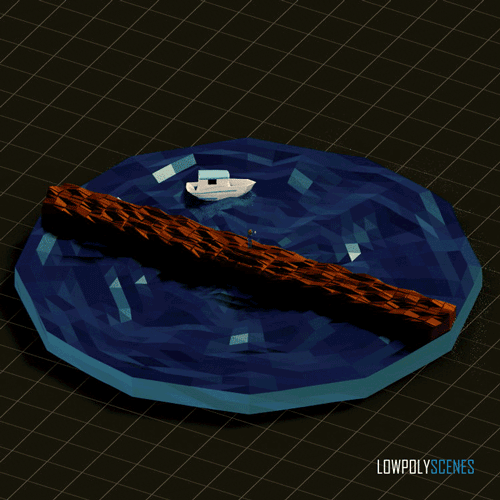
Moving on to Star Wars (1977), we have the Death Star trench run, and this one is almost kind of sad. Watching Luke and Vader bounce back and forth in a loop and seeing Vader just almost hit him every time makes me feel for the Sith Lord, at least more than the prequels ever did. You’ll get him one day, buddy (or at least his smuggler friend).
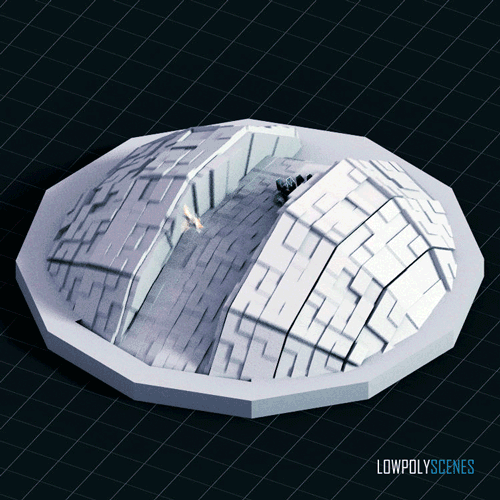
low-poly is a natural fit
Next up is Indiana Jones (1981) and its classic boulder chase scene, and seeing it from an overhead angle, that boulder is coming in fast. I’d assume he died if I didn’t know the source material, but sadly, he does survive to father Shia LaBeouf. You were so close, Indy!
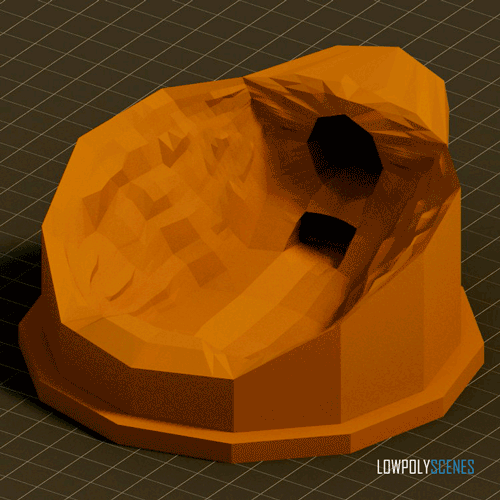
Coming in last is Back to the Future (1985), and I think it may be my favorite. It’s the scene where Rick—sorry—Doc shows off the time machine to Marty, and it’s probably the one where the low-poly aesthetic shines most. Here, Alberto has depicted the DeLorean’s time travelling by showing it turning into a stream of particles just as it makes the jump. It’s a nice detail that wasn’t in the original (though that did feature sparks in front of the car), but it fits so well that I almost hadn’t noticed it was new.
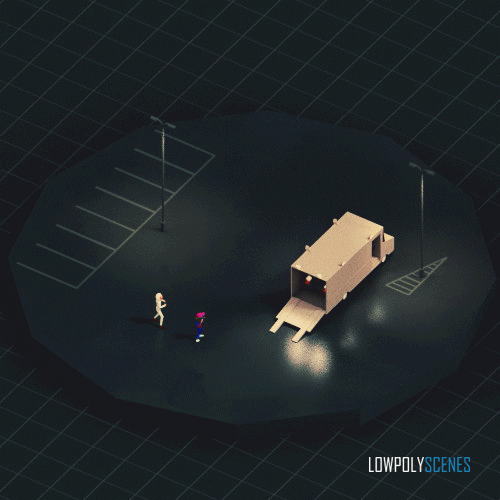
I’ve probably spent more time with these scenes at this point than I did with the originals, and there’s a reason for that: they remind me of the best parts of my childhood, depicted as I remember them rather than as they are. Combining ‘80s-’90s movie nostalgia with the low-poly look is a natural fit, as it was during the end of that era that low-poly started to become prominent. If you want to check out these GIFs for yourself, and see more as they come in, follow Alberto over on his Facebook page.
Oh, and here’s a bonus scene from Game of Thrones for ya, straight from Alberto with love, of course.
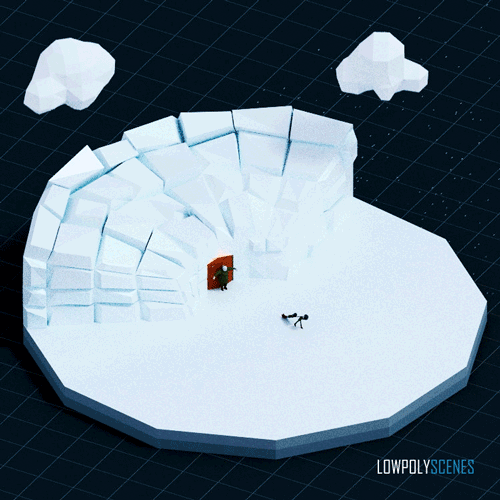
The post Iconic movie moments turned into gorgeous low-poly scenes appeared first on Kill Screen.
The Man Came Around is a political fable for our trying times
It seems fitting that I’m to write about The Man Came Around today. We’re going through a rare heatwave right now in the UK and a right wing government is currently wrestling us into a headlock. The Man Came Around is the total opposite: set in the frozen heart of an icy mountain, it tells the story of five exiles trying to escape a corporate democracy.
It’s the first game from Brussels-based studio Pipette Inc, a politically-charged adventure game that will ask you to try and look after these exiles as best you can. Amid a wave of right wing xenophobic sentiment, The Man Came Around challenges you to choose who lives and dies in your plucky group of exiles, promising tough decisions as they try to help you cross the Border—the heavily-guarded wall that separates the country from its poorer neighbors.
With the Syrian refugee crisis playing out across Europe right now, the game isn’t shy about taking a stance as it tries to get you to identify with refugees—it’s described as a political fable. Thierry Brimioulle, the game’s designer, says that it was originally called “To The Sky” and focused on survivors of a plane crash, but then “the Syrian Refugee crisis happened and the reaction of the European Union was just terrible. The camps, the fences, the xenophobia, it was just too much,” he said.
Wanting to do something about it, but feeling at a loss for how, Brimioulle decided to incorporate the themes into his debut game. “I think games have a huge potential to confront players with difficult situations,” he said. “To make them reflect on their own decisions and values, and it’s really something I want to do in my games.”
“You can decide at any time to simply leave someone behind”
This extends beyond the refugee angle and engulfs the game’s setting. The Federal State of Occida is where this particular political fable takes place, and it’s billed as an example of how a democratic system can be tied up in knots by special interests and unseen political forces.
Whether this allegorical commentary will work as a political fable remains to be seen, but the choices you’ll have to make will probably make you hate yourself—expect to wallow with hurt as the consequences play out. “You manage a group of five characters,” said Brimioulle. “But you can try to finish the game with only one and sacrifice the others in or to do so. You can decide at any time to simply leave someone behind, just because you don’t have enough food anymore or because they are hurt and slow you down.”
The Man Came Around comes across as a game full of risks and tough choices but the interesting fact is the refugees are well off. By showing the exiles struggling as they try to escape a country that, objectively, is worse-off, it could go a long way towards educating curious players on the reasons why people try to emigrate.
Yes, it could be a bleak experience, but sometimes the truth hurts.
The Man Came Around will be playable at Gamescom 2016. You can keep up with more info on the game on its website .
The post The Man Came Around is a political fable for our trying times appeared first on Kill Screen.
How do you explain the phenomenon of watching videogames?
For all our think pieces about interactive media, social media, and virtual reality, we are all still very much living in a culture of spectation. Big budget movies, music videos, episodic television, and professional sports: these are still the main sites of cultural cohesion for most people in the United States and in large parts of the world. And, it could be argued, that post-digital social-cultural practices are just spectation on a higher level. Perhaps Facebook and Twitter are just spectator-ready versions of other people’s lives. And, it seems that gaming—that most elementally interactive of activities—is becoming more and more intimately wrapped up with spectatorship, with non-participation.
I ended up encountering two of the biggest action games of recent years, Bloodborne (2015) and Dark Souls III, not as a player, but as a viewer. My roommate played through Hidetaka Miyazaki’s two dark visions almost back to back earlier this year. I started out sitting in our living room trying to get homework done, but becoming gradually more drawn into the dark fantasy otherworld that was being spooled out on the TV screen, one death at a time. I sat there, fascinated, even watching him fall time and time again to the same giant reindeer-wolf, the same graceful dancer-ghost.
Spectatorship has become braided into interactive media
But my revelatory encounter with non-participatory gaming can’t be isolated to just my own experience. Spectatorship has become completely braided into the practices of interactive media. And perhaps it always was to some degree: a lot of people I know spent whole afternoons with early consoles trading lives with the friend or sibling on the couch next to them. But the sophistication of recent forms of gaming spectatorship outstrips this experience, or mine with Dark Souls.
Just recently reports came out that the Manchester United Football club is looking to sign an esports team, particularly one playing Overwatch, to its promotional roster. The fact that one of the world’s biggest sports franchises is engaging with videogames speaks more than reams of viewer statistics to the impact of gaming spectatorship.

But this kind of gaming non-participation is really nothing new. The practice of watching highly-skilled professionals who have sunk countless hours into their chosen game is as old as pro-sports. We are always drawn to spectate feats of talent that we could not achieve ourselves. What fascinates me more is the way that even quotidian modes of play have been drawn into a matrix of non-participatory play.
Take the massive popularity of Let’s Plays for starters. YouTube videos devoted to sometimes full-length playthroughs of games, Let’s Plays have become a real cultural force in recent years. Swedish YouTube behemoth PewDiePie has become a sort of online-only household name off the strength of his Let’s Play videos alone, pulling in about 12 million USD in pre-tax income per annum. While a lot of Let’s Plays are fairly lame, with a guy or two making dumb voices and bad jokes, some are real works of fandom and aesthetics. In an article for the AV Club, Patrick Lee writes “Let’s Plays are also more than just guided tours through a game. They have the potential to be expressive works themselves.” In their possible mixing of critique and fandom, of walkthrough and aesthetics, of memory and reflection, Lets Plays at their best provide a window power of non-participatory gaming.
We are always drawn to spectate feats of talent
But these examples don’t really answer—and in fact just deepen—the question of why watching someone else play a game could be so engaging. Is spectating not counter to the interactivity that is supposed to be the core of videogames as entertainment? Is appreciating games in this way missing the point entirely? Still, I can’t shake the notion that my experiences with Bloodborne and Dark Souls III were just as profound as the ones my roommate had.
I’ve come up with two theories on the significance of non-participatory gaming that are interrelated in ways that can provide a more comprehensive explanation.
Theory #1: The Immersion Paradox
There seems to be an inverse relationship between my engagement with the mechanics of a game and my ability to appreciate its more diffuse aesthetic features. Or to put it another way, in my experience, the progressive challenges of a game are opposed, at some deep level, to the game’s design elements: art, architecture, sound etc. Blasting through planets in Super Mario Galaxy (2007), it is easy to let the carefully built spaces full of cartoon colors and gracefully defied physics become a blur, just a series of platforms to hop between. I might argue that all the design elements of the game deepen the immersion in an unconscious, gestalt-sort-of-way. But that line of thought doesn’t jive with the focused attentiveness that a deep dive into the visual (and sonic) arts requires.
Therefore, non-participatory gaming can come at the immersion paradox from the other side. By experiencing less immersion, by approaching the game from without—rather than from within—I am free to let my eye wander across the screen, free to let my eye light upon what interests me, rather than what might kill me, might contain an item, might allow me to progress a step further. This notion does much to explain why the Miyazaki games proved themselves so fruitful to this kind of gaming. The settings of Yharnam and Lothric are chock-a-block with detail: the agonized face of a statue, icebergs of melted wax, the pattern of bricks on an archway, the melancholy fall of golden leaves over the corpses of zombified knights. All these tiny elements caught my attention at the periphery of my roommate’s epic battle with deft timing and extreme difficulty. And while my tour through these locales was, in a sense, on rails, it probably also saved me from a thousand-hour playtime of me stopping to inspect the woodwork on a coffin or dying intentionally to some beast so I could see the wind in its fur.
Theory # 2: The Commentary Era
In his commonplace book, Anton Chekhov recorded a “professor” who said that “not Shakespeare, but the commentaries on him are the thing”: that is, the work of art isn’t as important as the accumulation of discussion around it. The Russian playwright meant this as a bit of gentle ribbing toward a blinkered academic, but, if anything, the early 21st century has taken it as a credo. Blu-Rays with a half dozen commentary tracks; album reissues with thick booklets of photos, set lists, track-by-track explications and nostalgic essays; reams upon reams of fan theories about every show ever; or, my favorite example, the Norton Critical Edition of Heart of Darkness (1899) with its 100 pages of story and 400 pages of textual apparatus. Ours is an era that likes to talk about art more than it likes looking at art.
And why not? Wasn’t art always meant to be a vehicle to socialization, to creating cultural cohesion and/or dislocation? If I expand the definition of non-participatory gaming to include not just Let’s Plays and livecasting but the whole empire of discussion and commentary about a game, it’s clear that playing without playing has become the real cultural site of gaming. This provides me with a vision of gaming that isn’t just a picture of a nerd in a room, but of players as atoms in a vast system of appreciation.
If I am to attempt a unified field between these two theories on non-participatory gaming it begins with this: that I have insisted on referring to it as “gaming,” not as “watching” or “spectating” for a reason. This reason being that I strongly feel, as many others do, that the boundaries of what is and isn’t gaming are fluid and shifting rapidly. And so, too, with what is and isn’t important in a given game. Finding new strategies for thoughtful play seems to me to be paramount in the future of the form, whether or not these strategies even involve picking up a controller at all.
Header via Pexels
The post How do you explain the phenomenon of watching videogames? appeared first on Kill Screen.
Go on a Kafkaesque adventure in The Real Texas
Sign up to receive each week’s Playlist e-mail here!
Also check out our full, interactive Playlist section.
THE REAL TEXAS (Windows, Mac)
BY KITTY LAMBDA GAMES
Sam is a real cowboy. He’s bored. So he goes on vacation to the land of castles and dragons—England. Once he arrives, Sam is soon sucked into a spinning portal where, on the other side, a purgatory awaits him. The place is called Strange, Texas, and it’s where he embarks on a series of problem-solving antics, punctuated by gunshots and fumbling conversation with the town’s kooky residents. The Real Texas came out in 2012 but has recently seen an upgrade for its Steam release, and now also has a mini DLC episode about a floating eye girl called Eyepop. It’s a Kafkaesque RPG adventure about reality, about shooting snakes, and about using robust point-and-click menus to kick objects every now and then. It’s got swagger, it’s got surreality, and most importantly it has secrets that, even after four years, still haven’t been discovered.
Perfect for: Real cowboys, Kafka readers, problem solvers
Playtime: 10 hours
The post Go on a Kafkaesque adventure in The Real Texas appeared first on Kill Screen.
July 20, 2016
Relax your body, tease your mind with artful puzzle game Klocki
Maciej Targoni, the creator of Klocki, describes himself as a Polish game developer that lives in the woods, and wants his puzzle games to communicate with players using only its mechanics. His game has no score, no timer, and no tutorial—just blocks and shapes. Mostly lines.
A distinct design style rooted in a minimal aesthetic is established within Klocki—but it’s not what defines it. Targoni was more interested in creating a game with sharp mechanics. It’s the simplicity and clarity of the gameplay that inspires the art, he says.
it’s actually pretty calming
Targoni’s early prototypes reaffirm this process. Scrolling through his Twitter feed offers an in-depth look at Klocki’s progression; the puzzle pieces are undeniably at the forefront, and have been since the beginning. It’s core concept remains quite consistent throughout it’s development lifespan, despite the shifting color palette.
Puzzles begin very simple; players simply have to swap tiles to connect lines. Slowly, Targoni introduces new features. There are dots, levers, and rotating tiles—each level builds upon the next, and puzzles evolve into three-dimensional spaces cluttered with knotted lines.
Even within the chaos of untangling puzzle after puzzle, Klocki doesn’t feel stressful. In fact, it’s actually pretty calming. This is likened to its ambient music that swells as each puzzle is solved, created by sound designer Wojciech Wasiak—who worked with Targoni on his previous puzzle release, Hook (2015).
That, and the missing clock. It’s an intentional decision to enforce the relaxing nature of Klocki. Each puzzle will likely last less than a few minutes, but if it takes a player longer, that’s okay, too.
Klocki was released July 13 on iOS, Android, and Steam, where you can buy it for under a dollar. A demo version is available for free on Kongregate . More information on Targoni and his games is available on the Rainbow Train website .
The post Relax your body, tease your mind with artful puzzle game Klocki appeared first on Kill Screen.
Direct all your love for Shadow of the Colossus this way
No Matter, a small team of three, began working on Prey for the Gods in 2014 for two reasons: to work on their own thing, and to make games similar to the ones that drove them in this direction in the first place.
It’s clear which games inspired the team, or at least, which single game had the biggest impact on them. Upon first looking at Prey for the Gods, the first thing anyone familiar with it is sure to think of is Team ICO’s Shadow of the Colossus (2005). That’s not an accident by any means; in fact, the studio itself cites Shadow of the Colossus as being one of the games it’s pulling ideas from, as well as others like Deus Ex, DayZ (2013), and Bloodborne (2015). That may sound like a mixed bag, but No Matter is confident that the elements they take from these games complement each other in surprisingly effortless ways.
Brian Parnell, No Matter’s director, compares it to the first time he tried prosciutto and melon. “I thought it was gross the first time I heard of it… who would think of such a thing!? Then I ate it and it [all made sense to me]. The balance of sweet and salt really opened my eyes. That may be a terrible analogy but for me it makes perfect sense.”
So what’s the result? In Prey for the Gods, players will control a lone, voiceless woman, from a third-person perspective, and traverse an island covered in snow. They’ll need to explore this unkind world in order to find food, weapons, and other resources, before tracking down one of the five giants that also inhabit the area. Exploration is greatly encouraged, but spending too long out in the cold without a plan could be the end of their adventure—and thanks to the game’s dynamic weather, they may sometimes be caught unprepared.
how defenseless they are while climbing
On the Kickstarter page for Prey for the Gods, No Matter explains the basic actions players will use throughout their time with the game: attack, move, dodge, and climb. Simple enough to pick up on, but learning specific things like how the character moves, how fast they move through deep snow, or how defenseless they are while climbing, will be the key to survival and victory. No specific directions of explanations will be given—players will have to ask and answer their own questions while exploring, and deal with whatever situation they are greeted with. “For us, the goal has always been about fighting the giants, and figuring out what is going on in the world,” said Parnell.
So far, the crowdfunding call has been going fairly well—the $300,000 goal is less than $50k away at the time of writing—it helped along by people being interested in the game’s obvious resemblance to Shadow of the Colossus. But Kickstarter has grown a reputation for attracting projects that end up going nowhere; money is wasted or the game at the other end is compromised and disappointing. Parnell is hoping to encourage a little more faith in people with Prey for the Gods.
“It saddens me when [people group all Kickstarter projects together]. When you look at what we’ve shown vs. [these other games], I think it’s a stark contrast. [Throughout] the campaign, we hope to change people’s minds and, at the very least, pledge $5. That way they can see our progress and always [pledge more later],” Parnell said. Assuming the funding goal is reached, the plan is to take the game beyond its current 25 percent completion so that it has five bosses to take down, but there are several stretch goals that, if met, would see the team creating up to three more bosses and releasing them as free DLC. Other stretch goals include additional animations, more armor and weapons, and an orchestral score.
According to the campaign page, the plan is to launch Prey for the Gods on PC and Mac (via Steam) in 2017, but as evidenced by an FAQ on the game’s website, the studio has no problem holding the game back until they feel it is truly finished. Should funding hit $600,000, the game will come to the PlayStation 4 and Xbox One, albeit sometime after the initial PC release.
Prey for the Gods currently has 16 days left until the campaign concludes. You can find out more info and back it on Kickstarter.

The post Direct all your love for Shadow of the Colossus this way appeared first on Kill Screen.
Persona 5 has a lot of new footage and it looks so good y’all
I’m already in love with Persona 5. I’ve probably been in love with Persona 5 all my life, even before it was announced. Persona 3 (2006) and Persona 4 (2008) are, arguably, two of the greatest games of all time. Hell, Persona 3 is my personal favorite game of all time.
The Persona series, starting from P3 on, lovingly meshed social sim elements with traditional RPG dungeon crawling— garnering widespread critical and commercial admiration. With its fourth-chronological installment (technically, Persona 3), the Persona series became bold and unlike anything else in the RPG realm. Whereas, the first few games in the series were more traditional, serious takes on the RPG genre, similar to the grander series Shin Megami Tensei that Persona is spun off from.
Persona 5 was first announced in 2013 for a late 2014 release. But as with all big releases, Persona 5 was pushed back again. And again. And again. Yet finally, the end is in sight. And there’s new footage to prove it. During Atlus’s latest Niconico Live streaming event, they revealed the first 18-minutes of the game, the Production I.G.-produced opening animation, a host of new “cooperation characters” (Persona 5’s answer to P3 and P4’s “Social Links”), a new sprawling dungeon, TV commercials, a web comic, and a sneak peek of the game’s anime adaptation. Oh, and a shitload of just plain gameplay. So, Atlus showed off a lot.
Persona 5 looks both familiar and totally fresh
In the game’s opening 18-minutes, we see the nameless protagonist confidently try to escape a casino after a heist. In the lengthy video, we get a sneak peek at the essence of Persona 5: a beautiful conglomeration of animated cutscenes, stealth-oriented sections of dungeon crawling, impeccably-stylized interface for battles and, of course, the game in action overall. Persona 5 looks both familiar and totally fresh. Reminiscent of its excellent predecessors, but amping up what makes the series notable to a nearly impossible degree. As a sucker for social sims, modern-setting RPGs, Shoji Meguro’s scores, and unfuckwithable style, Persona 5 is maybe the most exciting-looking RPG I’ve ever laid eyes on.
One of the most beloved aspects of the Persona series is that of “Social Links.” In Persona 3 and P4, the player can skip around town in their free time, strengthening relationships with friends and minor acquaintances—anyone from a party member in their dungeon crawling woes, to an elderly married couple that own a local bookstore. By spending time with people and boosting “Social Links,” their individual Arcanas that can fuse with the player’s Personas grow in power as well. In Persona 5, “Social Links” are swapped in favor of “Cooperation Characters,” which by their description, serve a similar purpose in socializing outside of dungeons actually benefiting battle purposes later on. In the latest “Co-op relationship” introductions, more of the quirky side characters were revealed. Like the Shinjuku-bound fortune teller Chihaya Mifune, or the dive bar-dwelling gossip reporter Ichiko Oya.
Persona 5 will also have an auto-generated infinite dungeon called the Mementos Dungeon—which the creators boast is larger than the entirety of Persona 4. In the Mementos Dungeon, the player’s adorable cat companion Morgana transforms into a fully-operational bus, making for ease of travel within the immense dungeon. Perhaps the most that can be said with this massive onslaught of fresh footage and news is that Persona 5 looks, above all else, fun and lively. It’s butterfly-stroking in a sea where JRPGs have grown dry and predictable, and Persona 5 wants to reinvigorate the genre to an already grander degree than its predecessors already have. I, for one, can’t wait to channel my inner Lupin the Third come February, but as an adorably lanky teen that moonlights as a demon negotiator.
Unleash your inner thief when Persona 5 is out in September of this year in Japan, and February 2017 for North America.
The post Persona 5 has a lot of new footage and it looks so good y’all appeared first on Kill Screen.
Nintendo’s new mini console relies on your memories of the ’80s
Between Humble Bundles and Steam sales, everyone loves a good collection of cheapo games. In the spirit of bundle-based generosity, Nintendo has announced a kind of physical manifestation of their Virtual Console in the form of the “NES Classic Edition.” The size of a 10-dollar sandwich, the NES Classic Edition will have a fixed library of 30 NES games, 28 of which are currently available on the Wii U Virtual Console. For the first time ever, Bubble Bobble (1986) and Final Fantasy (1987) will be legally playable in 1080p, having only been on the lower-resolution Wii Virtual Console and NES up to now.
The NES Classic Edition will retail for $60, or about half of what an original NES goes for on Ebay. On the Virtual Console, the 30 NES games included have a value between $150 and $180. If you bought 30 NES games in 1990, it would have run you $1,500 (around $2,800 if you adjust for inflation). Of course, a Raspberry Pi, with all its storage and computing power, is only $35, and I found 19 NES emulators in about 30 seconds on Google.
“rediscover the joy of NES games”
While Nintendo’s reputation for cashing in on nostalgia is not undeserved, these games are all from the late 80s or early 90s. It would be difficult to argue that you shouldn’t have to pay for a copy of Lethal Weapon (1987) or Julia Child’s The Way to Cook (1989), although both of those can be found for less than a dollar on Amazon.
I don’t think Nintendo would bother to manufacture this pork chop-sized console if they didn’t think it would sell. Their data from Virtual Console sales presumably suggests that the market for NES games is still a large one, and the high resale prices of original consoles and games would back that up. Still, I wonder if people are really up to “rediscover the joy of NES games” for, like, the fourth or fifth time.
The NES Classic will arrive on November 11th, just in time for Veterans Day, and you can find out more about it on its website.
The post Nintendo’s new mini console relies on your memories of the ’80s appeared first on Kill Screen.
Kill Screen Magazine's Blog
- Kill Screen Magazine's profile
- 4 followers




